Contactless Payment Systems Analysis
VerifiedAdded on 2020/03/01
|10
|2549
|95
AI Summary
This assignment delves into the world of contactless payment systems. It requires students to research and analyze various aspects of these systems, including their advantages, disadvantages, technological underpinnings (like RFID), consumer implications, and real-world case studies. The goal is to provide a thorough understanding of the current state and future trajectory of contactless payments.
Contribute Materials
Your contribution can guide someone’s learning journey. Share your
documents today.

IT management Issues
Secure Best Marks with AI Grader
Need help grading? Try our AI Grader for instant feedback on your assignments.
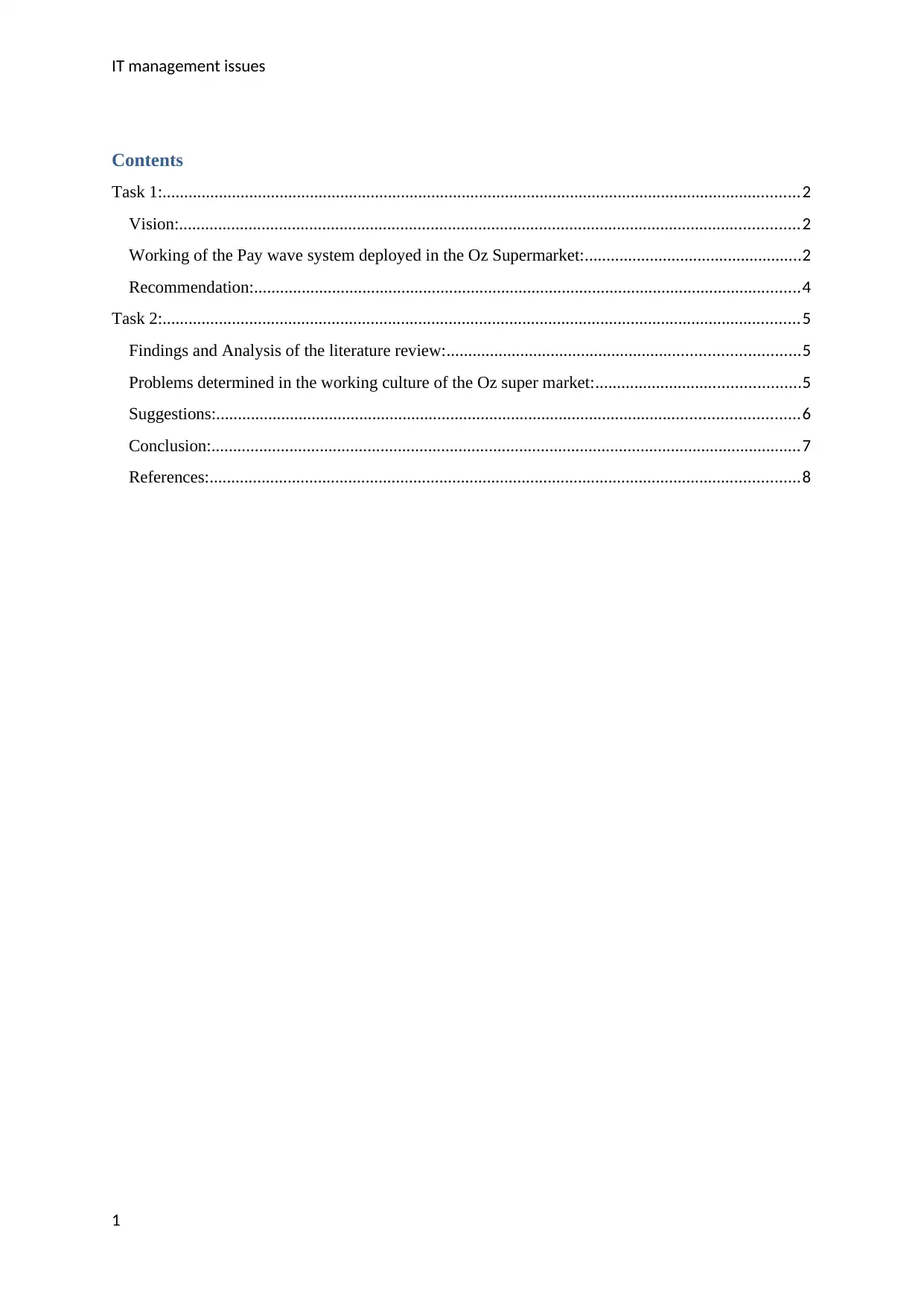
IT management issues
Contents
Task 1:...................................................................................................................................................2
Vision:...............................................................................................................................................2
Working of the Pay wave system deployed in the Oz Supermarket:..................................................2
Recommendation:..............................................................................................................................4
Task 2:...................................................................................................................................................5
Findings and Analysis of the literature review:.................................................................................5
Problems determined in the working culture of the Oz super market:...............................................5
Suggestions:......................................................................................................................................6
Conclusion:........................................................................................................................................7
References:........................................................................................................................................8
1
Contents
Task 1:...................................................................................................................................................2
Vision:...............................................................................................................................................2
Working of the Pay wave system deployed in the Oz Supermarket:..................................................2
Recommendation:..............................................................................................................................4
Task 2:...................................................................................................................................................5
Findings and Analysis of the literature review:.................................................................................5
Problems determined in the working culture of the Oz super market:...............................................5
Suggestions:......................................................................................................................................6
Conclusion:........................................................................................................................................7
References:........................................................................................................................................8
1
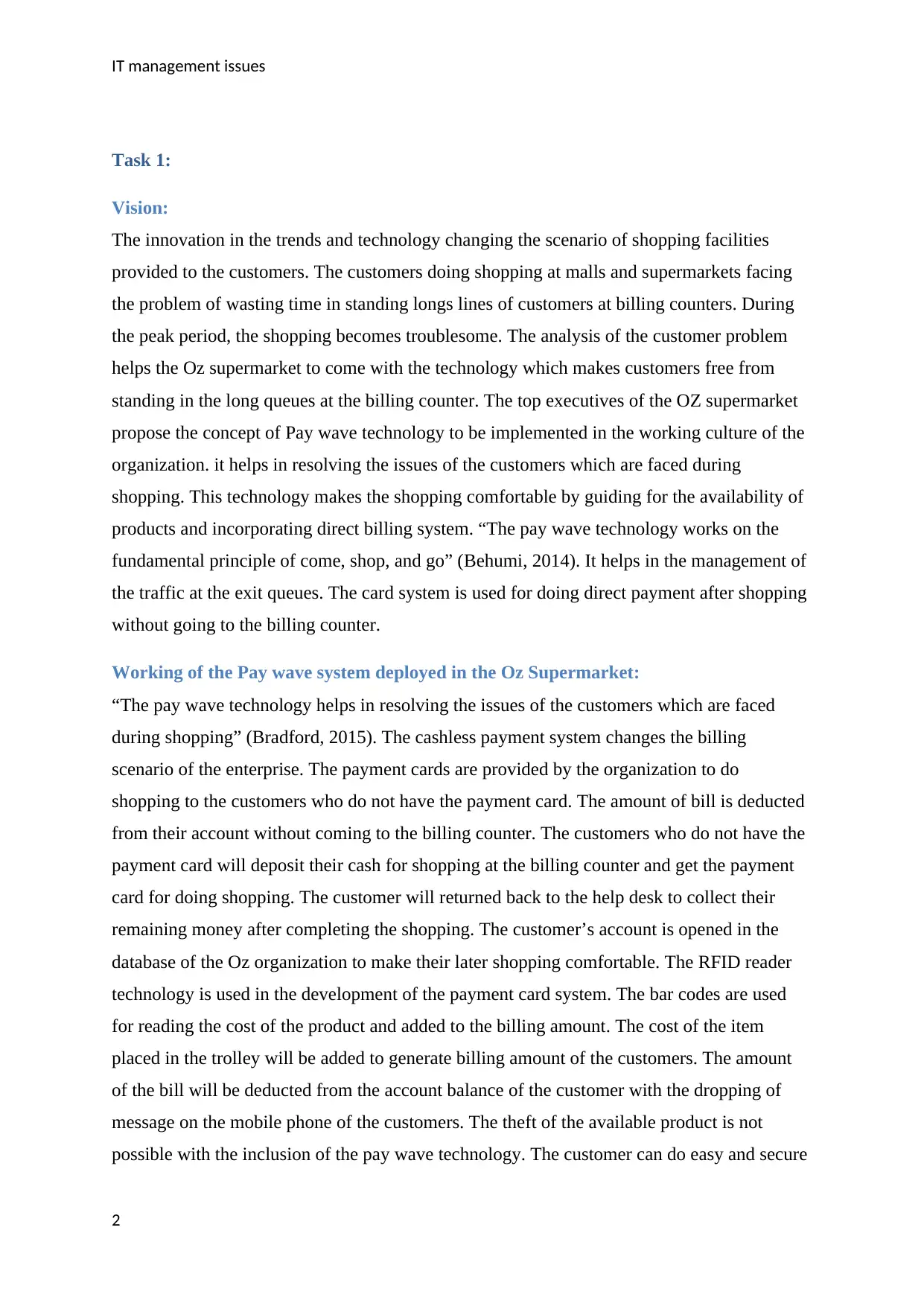
IT management issues
Task 1:
Vision:
The innovation in the trends and technology changing the scenario of shopping facilities
provided to the customers. The customers doing shopping at malls and supermarkets facing
the problem of wasting time in standing longs lines of customers at billing counters. During
the peak period, the shopping becomes troublesome. The analysis of the customer problem
helps the Oz supermarket to come with the technology which makes customers free from
standing in the long queues at the billing counter. The top executives of the OZ supermarket
propose the concept of Pay wave technology to be implemented in the working culture of the
organization. it helps in resolving the issues of the customers which are faced during
shopping. This technology makes the shopping comfortable by guiding for the availability of
products and incorporating direct billing system. “The pay wave technology works on the
fundamental principle of come, shop, and go” (Behumi, 2014). It helps in the management of
the traffic at the exit queues. The card system is used for doing direct payment after shopping
without going to the billing counter.
Working of the Pay wave system deployed in the Oz Supermarket:
“The pay wave technology helps in resolving the issues of the customers which are faced
during shopping” (Bradford, 2015). The cashless payment system changes the billing
scenario of the enterprise. The payment cards are provided by the organization to do
shopping to the customers who do not have the payment card. The amount of bill is deducted
from their account without coming to the billing counter. The customers who do not have the
payment card will deposit their cash for shopping at the billing counter and get the payment
card for doing shopping. The customer will returned back to the help desk to collect their
remaining money after completing the shopping. The customer’s account is opened in the
database of the Oz organization to make their later shopping comfortable. The RFID reader
technology is used in the development of the payment card system. The bar codes are used
for reading the cost of the product and added to the billing amount. The cost of the item
placed in the trolley will be added to generate billing amount of the customers. The amount
of the bill will be deducted from the account balance of the customer with the dropping of
message on the mobile phone of the customers. The theft of the available product is not
possible with the inclusion of the pay wave technology. The customer can do easy and secure
2
Task 1:
Vision:
The innovation in the trends and technology changing the scenario of shopping facilities
provided to the customers. The customers doing shopping at malls and supermarkets facing
the problem of wasting time in standing longs lines of customers at billing counters. During
the peak period, the shopping becomes troublesome. The analysis of the customer problem
helps the Oz supermarket to come with the technology which makes customers free from
standing in the long queues at the billing counter. The top executives of the OZ supermarket
propose the concept of Pay wave technology to be implemented in the working culture of the
organization. it helps in resolving the issues of the customers which are faced during
shopping. This technology makes the shopping comfortable by guiding for the availability of
products and incorporating direct billing system. “The pay wave technology works on the
fundamental principle of come, shop, and go” (Behumi, 2014). It helps in the management of
the traffic at the exit queues. The card system is used for doing direct payment after shopping
without going to the billing counter.
Working of the Pay wave system deployed in the Oz Supermarket:
“The pay wave technology helps in resolving the issues of the customers which are faced
during shopping” (Bradford, 2015). The cashless payment system changes the billing
scenario of the enterprise. The payment cards are provided by the organization to do
shopping to the customers who do not have the payment card. The amount of bill is deducted
from their account without coming to the billing counter. The customers who do not have the
payment card will deposit their cash for shopping at the billing counter and get the payment
card for doing shopping. The customer will returned back to the help desk to collect their
remaining money after completing the shopping. The customer’s account is opened in the
database of the Oz organization to make their later shopping comfortable. The RFID reader
technology is used in the development of the payment card system. The bar codes are used
for reading the cost of the product and added to the billing amount. The cost of the item
placed in the trolley will be added to generate billing amount of the customers. The amount
of the bill will be deducted from the account balance of the customer with the dropping of
message on the mobile phone of the customers. The theft of the available product is not
possible with the inclusion of the pay wave technology. The customer can do easy and secure
2
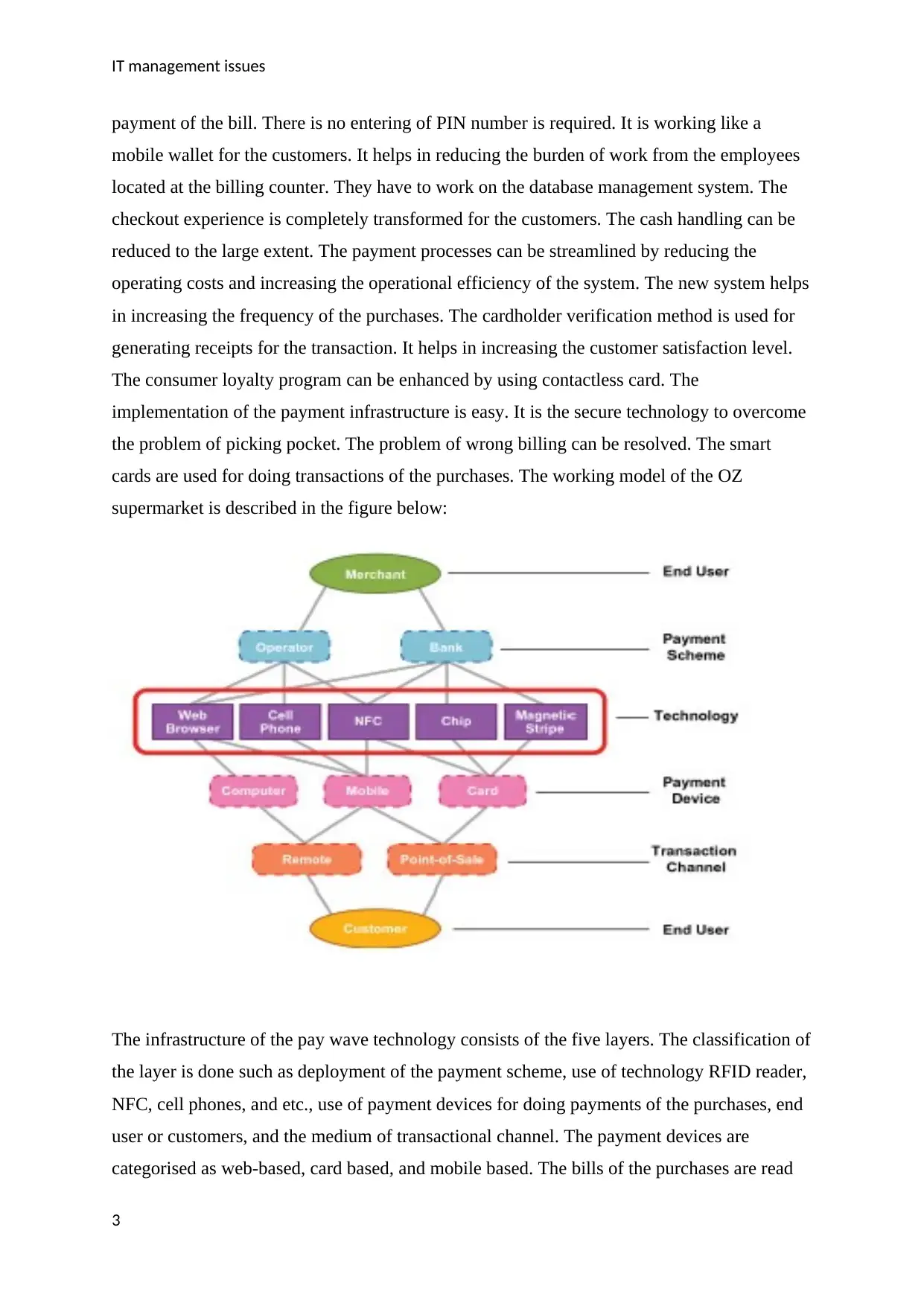
IT management issues
payment of the bill. There is no entering of PIN number is required. It is working like a
mobile wallet for the customers. It helps in reducing the burden of work from the employees
located at the billing counter. They have to work on the database management system. The
checkout experience is completely transformed for the customers. The cash handling can be
reduced to the large extent. The payment processes can be streamlined by reducing the
operating costs and increasing the operational efficiency of the system. The new system helps
in increasing the frequency of the purchases. The cardholder verification method is used for
generating receipts for the transaction. It helps in increasing the customer satisfaction level.
The consumer loyalty program can be enhanced by using contactless card. The
implementation of the payment infrastructure is easy. It is the secure technology to overcome
the problem of picking pocket. The problem of wrong billing can be resolved. The smart
cards are used for doing transactions of the purchases. The working model of the OZ
supermarket is described in the figure below:
The infrastructure of the pay wave technology consists of the five layers. The classification of
the layer is done such as deployment of the payment scheme, use of technology RFID reader,
NFC, cell phones, and etc., use of payment devices for doing payments of the purchases, end
user or customers, and the medium of transactional channel. The payment devices are
categorised as web-based, card based, and mobile based. The bills of the purchases are read
3
payment of the bill. There is no entering of PIN number is required. It is working like a
mobile wallet for the customers. It helps in reducing the burden of work from the employees
located at the billing counter. They have to work on the database management system. The
checkout experience is completely transformed for the customers. The cash handling can be
reduced to the large extent. The payment processes can be streamlined by reducing the
operating costs and increasing the operational efficiency of the system. The new system helps
in increasing the frequency of the purchases. The cardholder verification method is used for
generating receipts for the transaction. It helps in increasing the customer satisfaction level.
The consumer loyalty program can be enhanced by using contactless card. The
implementation of the payment infrastructure is easy. It is the secure technology to overcome
the problem of picking pocket. The problem of wrong billing can be resolved. The smart
cards are used for doing transactions of the purchases. The working model of the OZ
supermarket is described in the figure below:
The infrastructure of the pay wave technology consists of the five layers. The classification of
the layer is done such as deployment of the payment scheme, use of technology RFID reader,
NFC, cell phones, and etc., use of payment devices for doing payments of the purchases, end
user or customers, and the medium of transactional channel. The payment devices are
categorised as web-based, card based, and mobile based. The bills of the purchases are read
3
Secure Best Marks with AI Grader
Need help grading? Try our AI Grader for instant feedback on your assignments.
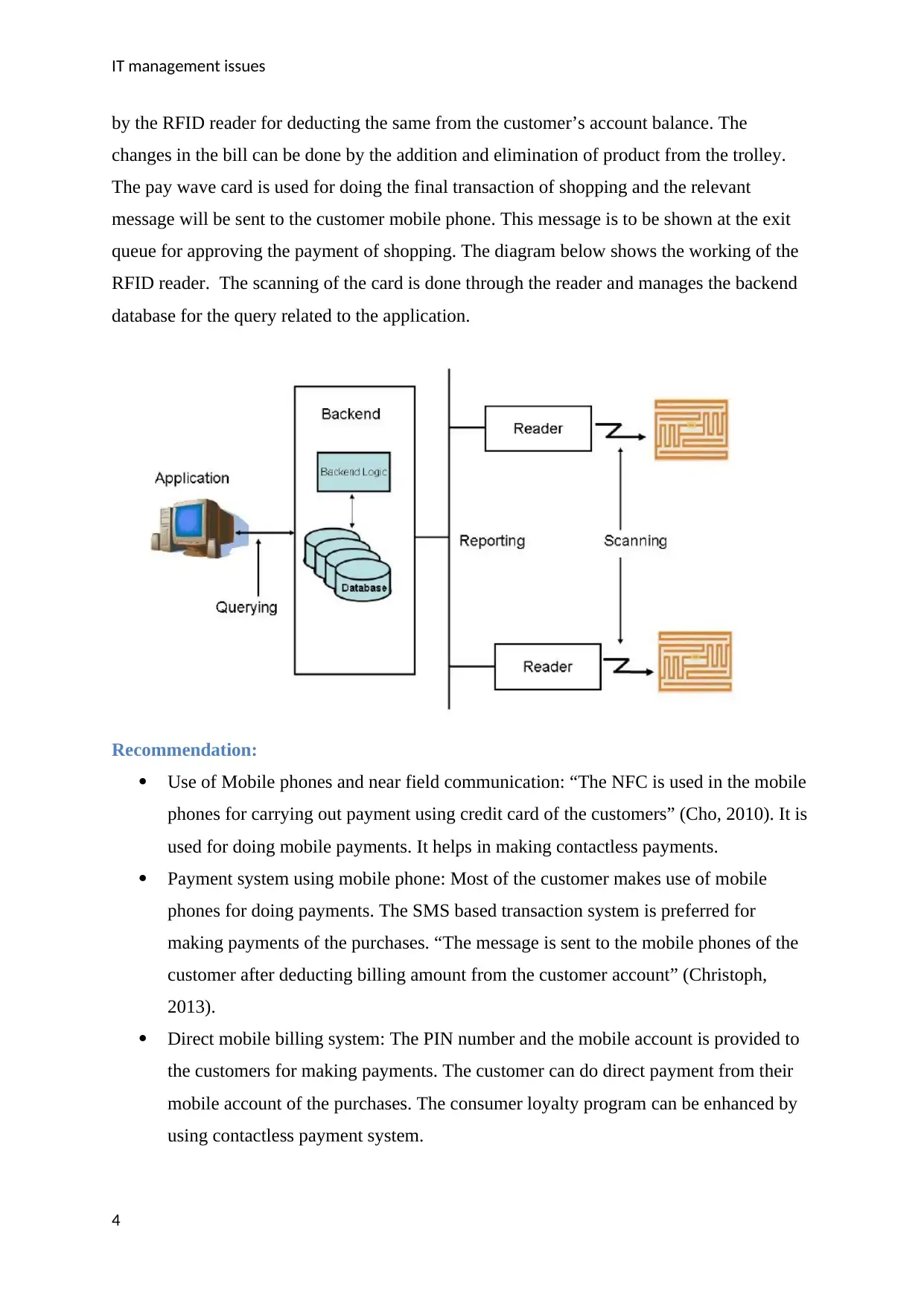
IT management issues
by the RFID reader for deducting the same from the customer’s account balance. The
changes in the bill can be done by the addition and elimination of product from the trolley.
The pay wave card is used for doing the final transaction of shopping and the relevant
message will be sent to the customer mobile phone. This message is to be shown at the exit
queue for approving the payment of shopping. The diagram below shows the working of the
RFID reader. The scanning of the card is done through the reader and manages the backend
database for the query related to the application.
Recommendation:
Use of Mobile phones and near field communication: “The NFC is used in the mobile
phones for carrying out payment using credit card of the customers” (Cho, 2010). It is
used for doing mobile payments. It helps in making contactless payments.
Payment system using mobile phone: Most of the customer makes use of mobile
phones for doing payments. The SMS based transaction system is preferred for
making payments of the purchases. “The message is sent to the mobile phones of the
customer after deducting billing amount from the customer account” (Christoph,
2013).
Direct mobile billing system: The PIN number and the mobile account is provided to
the customers for making payments. The customer can do direct payment from their
mobile account of the purchases. The consumer loyalty program can be enhanced by
using contactless payment system.
4
by the RFID reader for deducting the same from the customer’s account balance. The
changes in the bill can be done by the addition and elimination of product from the trolley.
The pay wave card is used for doing the final transaction of shopping and the relevant
message will be sent to the customer mobile phone. This message is to be shown at the exit
queue for approving the payment of shopping. The diagram below shows the working of the
RFID reader. The scanning of the card is done through the reader and manages the backend
database for the query related to the application.
Recommendation:
Use of Mobile phones and near field communication: “The NFC is used in the mobile
phones for carrying out payment using credit card of the customers” (Cho, 2010). It is
used for doing mobile payments. It helps in making contactless payments.
Payment system using mobile phone: Most of the customer makes use of mobile
phones for doing payments. The SMS based transaction system is preferred for
making payments of the purchases. “The message is sent to the mobile phones of the
customer after deducting billing amount from the customer account” (Christoph,
2013).
Direct mobile billing system: The PIN number and the mobile account is provided to
the customers for making payments. The customer can do direct payment from their
mobile account of the purchases. The consumer loyalty program can be enhanced by
using contactless payment system.
4
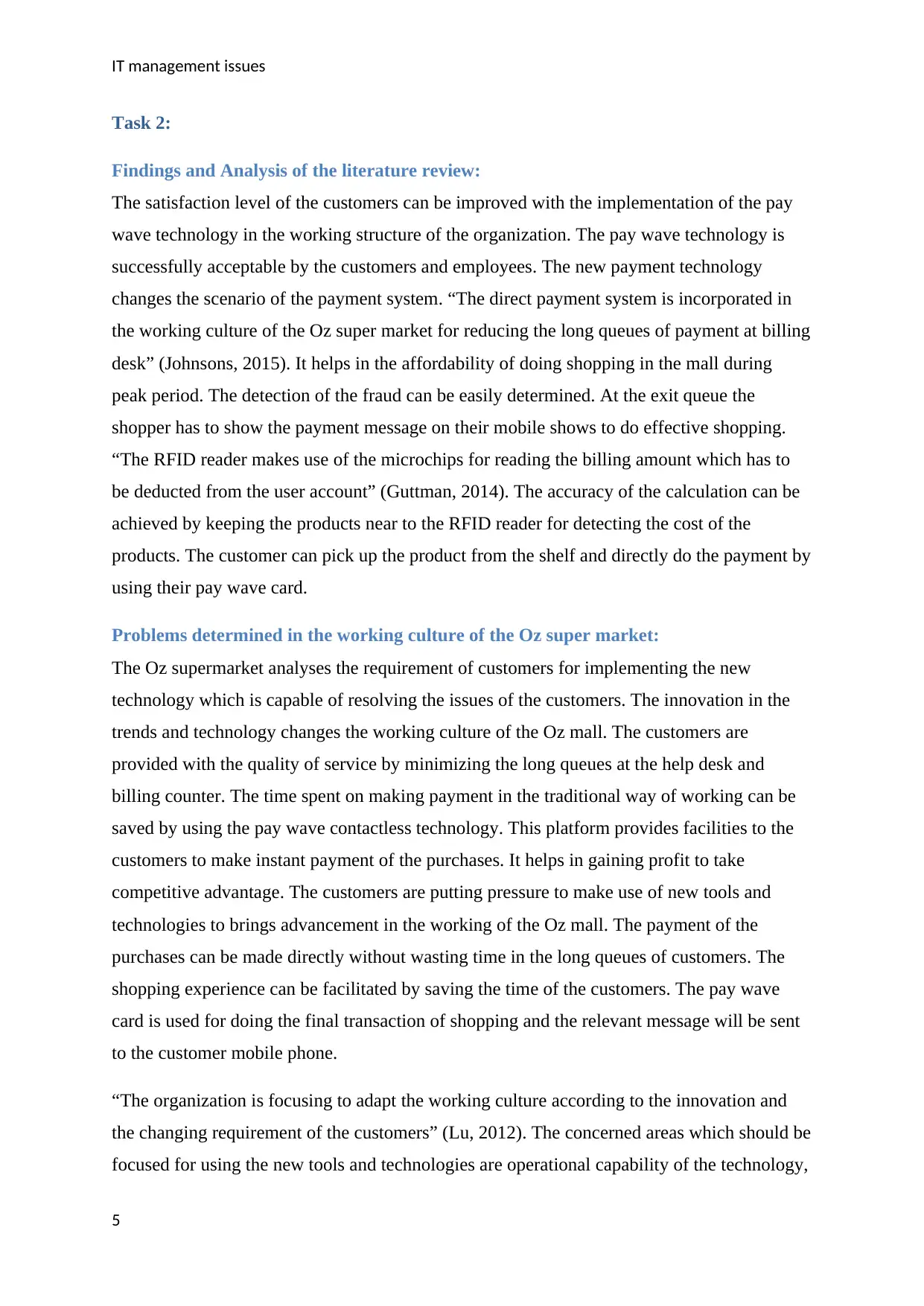
IT management issues
Task 2:
Findings and Analysis of the literature review:
The satisfaction level of the customers can be improved with the implementation of the pay
wave technology in the working structure of the organization. The pay wave technology is
successfully acceptable by the customers and employees. The new payment technology
changes the scenario of the payment system. “The direct payment system is incorporated in
the working culture of the Oz super market for reducing the long queues of payment at billing
desk” (Johnsons, 2015). It helps in the affordability of doing shopping in the mall during
peak period. The detection of the fraud can be easily determined. At the exit queue the
shopper has to show the payment message on their mobile shows to do effective shopping.
“The RFID reader makes use of the microchips for reading the billing amount which has to
be deducted from the user account” (Guttman, 2014). The accuracy of the calculation can be
achieved by keeping the products near to the RFID reader for detecting the cost of the
products. The customer can pick up the product from the shelf and directly do the payment by
using their pay wave card.
Problems determined in the working culture of the Oz super market:
The Oz supermarket analyses the requirement of customers for implementing the new
technology which is capable of resolving the issues of the customers. The innovation in the
trends and technology changes the working culture of the Oz mall. The customers are
provided with the quality of service by minimizing the long queues at the help desk and
billing counter. The time spent on making payment in the traditional way of working can be
saved by using the pay wave contactless technology. This platform provides facilities to the
customers to make instant payment of the purchases. It helps in gaining profit to take
competitive advantage. The customers are putting pressure to make use of new tools and
technologies to brings advancement in the working of the Oz mall. The payment of the
purchases can be made directly without wasting time in the long queues of customers. The
shopping experience can be facilitated by saving the time of the customers. The pay wave
card is used for doing the final transaction of shopping and the relevant message will be sent
to the customer mobile phone.
“The organization is focusing to adapt the working culture according to the innovation and
the changing requirement of the customers” (Lu, 2012). The concerned areas which should be
focused for using the new tools and technologies are operational capability of the technology,
5
Task 2:
Findings and Analysis of the literature review:
The satisfaction level of the customers can be improved with the implementation of the pay
wave technology in the working structure of the organization. The pay wave technology is
successfully acceptable by the customers and employees. The new payment technology
changes the scenario of the payment system. “The direct payment system is incorporated in
the working culture of the Oz super market for reducing the long queues of payment at billing
desk” (Johnsons, 2015). It helps in the affordability of doing shopping in the mall during
peak period. The detection of the fraud can be easily determined. At the exit queue the
shopper has to show the payment message on their mobile shows to do effective shopping.
“The RFID reader makes use of the microchips for reading the billing amount which has to
be deducted from the user account” (Guttman, 2014). The accuracy of the calculation can be
achieved by keeping the products near to the RFID reader for detecting the cost of the
products. The customer can pick up the product from the shelf and directly do the payment by
using their pay wave card.
Problems determined in the working culture of the Oz super market:
The Oz supermarket analyses the requirement of customers for implementing the new
technology which is capable of resolving the issues of the customers. The innovation in the
trends and technology changes the working culture of the Oz mall. The customers are
provided with the quality of service by minimizing the long queues at the help desk and
billing counter. The time spent on making payment in the traditional way of working can be
saved by using the pay wave contactless technology. This platform provides facilities to the
customers to make instant payment of the purchases. It helps in gaining profit to take
competitive advantage. The customers are putting pressure to make use of new tools and
technologies to brings advancement in the working of the Oz mall. The payment of the
purchases can be made directly without wasting time in the long queues of customers. The
shopping experience can be facilitated by saving the time of the customers. The pay wave
card is used for doing the final transaction of shopping and the relevant message will be sent
to the customer mobile phone.
“The organization is focusing to adapt the working culture according to the innovation and
the changing requirement of the customers” (Lu, 2012). The concerned areas which should be
focused for using the new tools and technologies are operational capability of the technology,
5
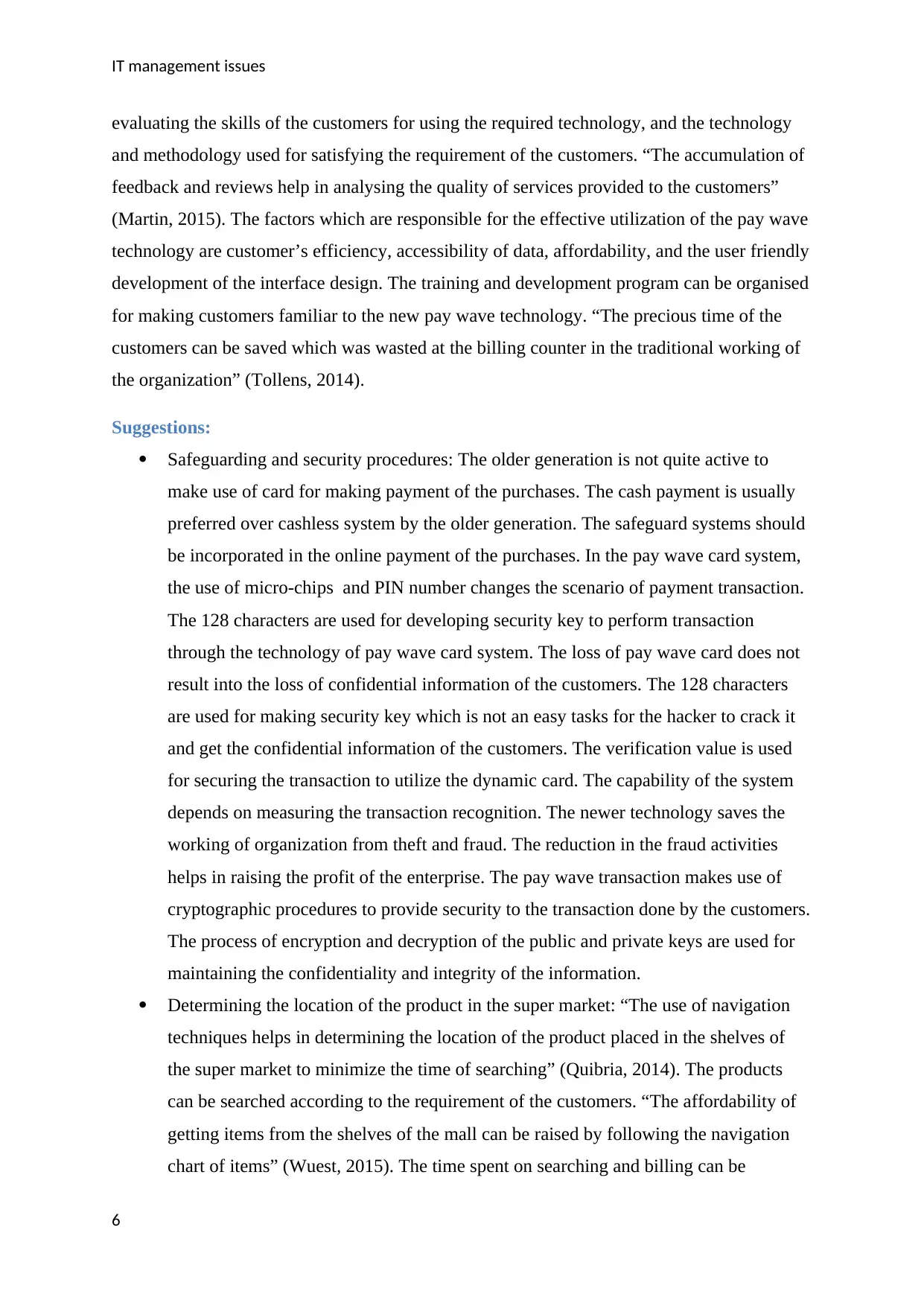
IT management issues
evaluating the skills of the customers for using the required technology, and the technology
and methodology used for satisfying the requirement of the customers. “The accumulation of
feedback and reviews help in analysing the quality of services provided to the customers”
(Martin, 2015). The factors which are responsible for the effective utilization of the pay wave
technology are customer’s efficiency, accessibility of data, affordability, and the user friendly
development of the interface design. The training and development program can be organised
for making customers familiar to the new pay wave technology. “The precious time of the
customers can be saved which was wasted at the billing counter in the traditional working of
the organization” (Tollens, 2014).
Suggestions:
Safeguarding and security procedures: The older generation is not quite active to
make use of card for making payment of the purchases. The cash payment is usually
preferred over cashless system by the older generation. The safeguard systems should
be incorporated in the online payment of the purchases. In the pay wave card system,
the use of micro-chips and PIN number changes the scenario of payment transaction.
The 128 characters are used for developing security key to perform transaction
through the technology of pay wave card system. The loss of pay wave card does not
result into the loss of confidential information of the customers. The 128 characters
are used for making security key which is not an easy tasks for the hacker to crack it
and get the confidential information of the customers. The verification value is used
for securing the transaction to utilize the dynamic card. The capability of the system
depends on measuring the transaction recognition. The newer technology saves the
working of organization from theft and fraud. The reduction in the fraud activities
helps in raising the profit of the enterprise. The pay wave transaction makes use of
cryptographic procedures to provide security to the transaction done by the customers.
The process of encryption and decryption of the public and private keys are used for
maintaining the confidentiality and integrity of the information.
Determining the location of the product in the super market: “The use of navigation
techniques helps in determining the location of the product placed in the shelves of
the super market to minimize the time of searching” (Quibria, 2014). The products
can be searched according to the requirement of the customers. “The affordability of
getting items from the shelves of the mall can be raised by following the navigation
chart of items” (Wuest, 2015). The time spent on searching and billing can be
6
evaluating the skills of the customers for using the required technology, and the technology
and methodology used for satisfying the requirement of the customers. “The accumulation of
feedback and reviews help in analysing the quality of services provided to the customers”
(Martin, 2015). The factors which are responsible for the effective utilization of the pay wave
technology are customer’s efficiency, accessibility of data, affordability, and the user friendly
development of the interface design. The training and development program can be organised
for making customers familiar to the new pay wave technology. “The precious time of the
customers can be saved which was wasted at the billing counter in the traditional working of
the organization” (Tollens, 2014).
Suggestions:
Safeguarding and security procedures: The older generation is not quite active to
make use of card for making payment of the purchases. The cash payment is usually
preferred over cashless system by the older generation. The safeguard systems should
be incorporated in the online payment of the purchases. In the pay wave card system,
the use of micro-chips and PIN number changes the scenario of payment transaction.
The 128 characters are used for developing security key to perform transaction
through the technology of pay wave card system. The loss of pay wave card does not
result into the loss of confidential information of the customers. The 128 characters
are used for making security key which is not an easy tasks for the hacker to crack it
and get the confidential information of the customers. The verification value is used
for securing the transaction to utilize the dynamic card. The capability of the system
depends on measuring the transaction recognition. The newer technology saves the
working of organization from theft and fraud. The reduction in the fraud activities
helps in raising the profit of the enterprise. The pay wave transaction makes use of
cryptographic procedures to provide security to the transaction done by the customers.
The process of encryption and decryption of the public and private keys are used for
maintaining the confidentiality and integrity of the information.
Determining the location of the product in the super market: “The use of navigation
techniques helps in determining the location of the product placed in the shelves of
the super market to minimize the time of searching” (Quibria, 2014). The products
can be searched according to the requirement of the customers. “The affordability of
getting items from the shelves of the mall can be raised by following the navigation
chart of items” (Wuest, 2015). The time spent on searching and billing can be
6
Paraphrase This Document
Need a fresh take? Get an instant paraphrase of this document with our AI Paraphraser
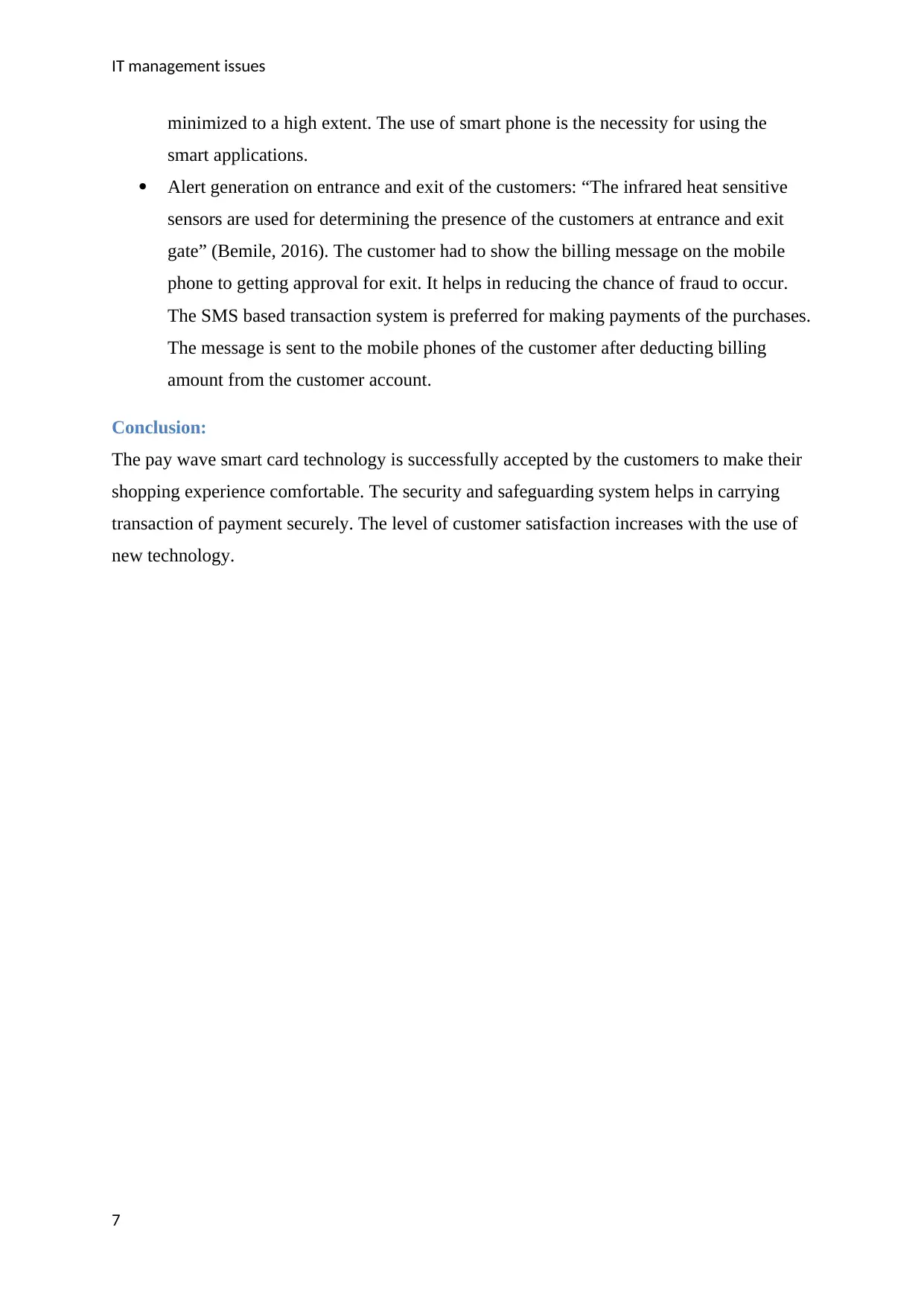
IT management issues
minimized to a high extent. The use of smart phone is the necessity for using the
smart applications.
Alert generation on entrance and exit of the customers: “The infrared heat sensitive
sensors are used for determining the presence of the customers at entrance and exit
gate” (Bemile, 2016). The customer had to show the billing message on the mobile
phone to getting approval for exit. It helps in reducing the chance of fraud to occur.
The SMS based transaction system is preferred for making payments of the purchases.
The message is sent to the mobile phones of the customer after deducting billing
amount from the customer account.
Conclusion:
The pay wave smart card technology is successfully accepted by the customers to make their
shopping experience comfortable. The security and safeguarding system helps in carrying
transaction of payment securely. The level of customer satisfaction increases with the use of
new technology.
7
minimized to a high extent. The use of smart phone is the necessity for using the
smart applications.
Alert generation on entrance and exit of the customers: “The infrared heat sensitive
sensors are used for determining the presence of the customers at entrance and exit
gate” (Bemile, 2016). The customer had to show the billing message on the mobile
phone to getting approval for exit. It helps in reducing the chance of fraud to occur.
The SMS based transaction system is preferred for making payments of the purchases.
The message is sent to the mobile phones of the customer after deducting billing
amount from the customer account.
Conclusion:
The pay wave smart card technology is successfully accepted by the customers to make their
shopping experience comfortable. The security and safeguarding system helps in carrying
transaction of payment securely. The level of customer satisfaction increases with the use of
new technology.
7
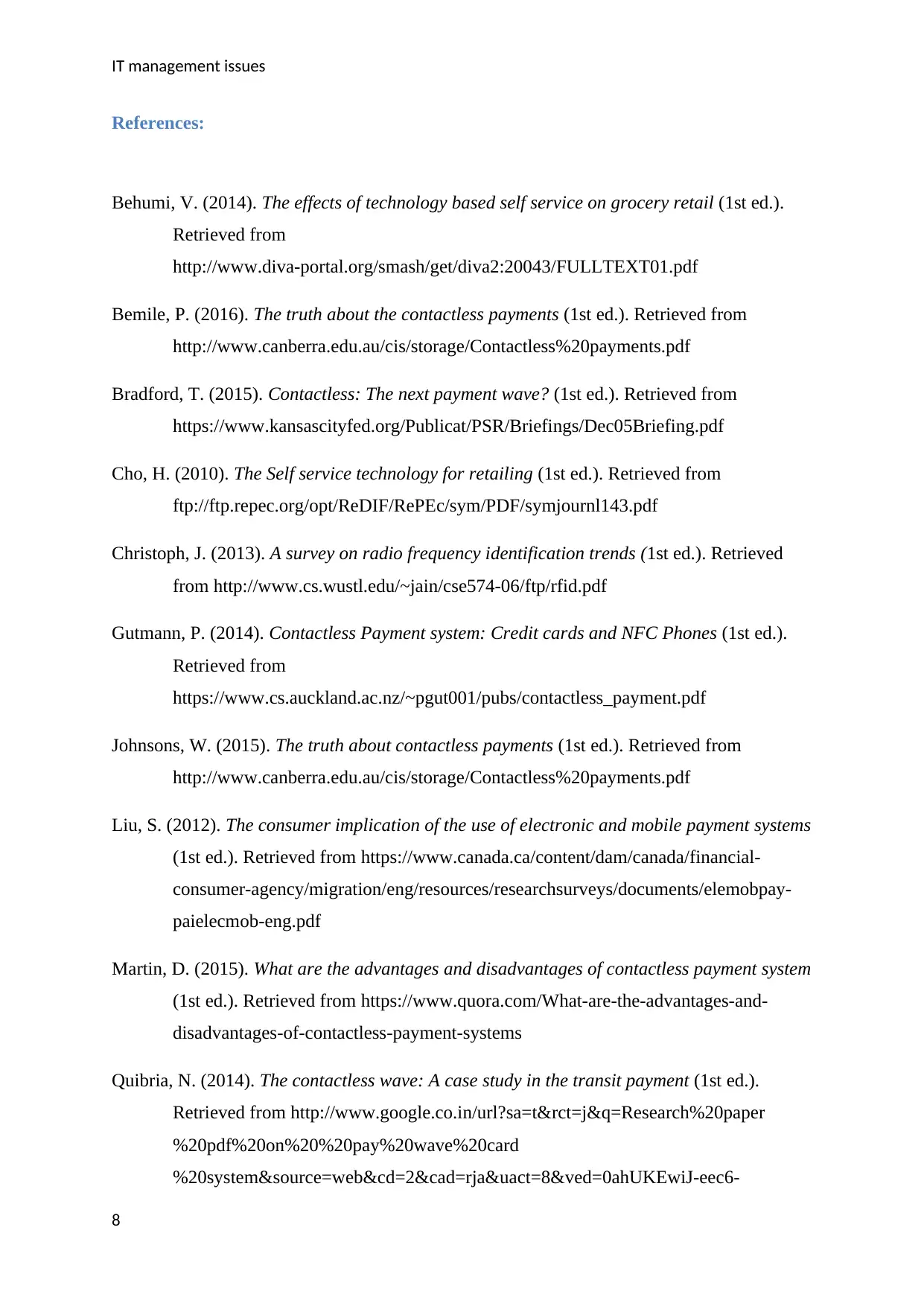
IT management issues
References:
Behumi, V. (2014). The effects of technology based self service on grocery retail (1st ed.).
Retrieved from
http://www.diva-portal.org/smash/get/diva2:20043/FULLTEXT01.pdf
Bemile, P. (2016). The truth about the contactless payments (1st ed.). Retrieved from
http://www.canberra.edu.au/cis/storage/Contactless%20payments.pdf
Bradford, T. (2015). Contactless: The next payment wave? (1st ed.). Retrieved from
https://www.kansascityfed.org/Publicat/PSR/Briefings/Dec05Briefing.pdf
Cho, H. (2010). The Self service technology for retailing (1st ed.). Retrieved from
ftp://ftp.repec.org/opt/ReDIF/RePEc/sym/PDF/symjournl143.pdf
Christoph, J. (2013). A survey on radio frequency identification trends (1st ed.). Retrieved
from http://www.cs.wustl.edu/~jain/cse574-06/ftp/rfid.pdf
Gutmann, P. (2014). Contactless Payment system: Credit cards and NFC Phones (1st ed.).
Retrieved from
https://www.cs.auckland.ac.nz/~pgut001/pubs/contactless_payment.pdf
Johnsons, W. (2015). The truth about contactless payments (1st ed.). Retrieved from
http://www.canberra.edu.au/cis/storage/Contactless%20payments.pdf
Liu, S. (2012). The consumer implication of the use of electronic and mobile payment systems
(1st ed.). Retrieved from https://www.canada.ca/content/dam/canada/financial-
consumer-agency/migration/eng/resources/researchsurveys/documents/elemobpay-
paielecmob-eng.pdf
Martin, D. (2015). What are the advantages and disadvantages of contactless payment system
(1st ed.). Retrieved from https://www.quora.com/What-are-the-advantages-and-
disadvantages-of-contactless-payment-systems
Quibria, N. (2014). The contactless wave: A case study in the transit payment (1st ed.).
Retrieved from http://www.google.co.in/url?sa=t&rct=j&q=Research%20paper
%20pdf%20on%20%20pay%20wave%20card
%20system&source=web&cd=2&cad=rja&uact=8&ved=0ahUKEwiJ-eec6-
8
References:
Behumi, V. (2014). The effects of technology based self service on grocery retail (1st ed.).
Retrieved from
http://www.diva-portal.org/smash/get/diva2:20043/FULLTEXT01.pdf
Bemile, P. (2016). The truth about the contactless payments (1st ed.). Retrieved from
http://www.canberra.edu.au/cis/storage/Contactless%20payments.pdf
Bradford, T. (2015). Contactless: The next payment wave? (1st ed.). Retrieved from
https://www.kansascityfed.org/Publicat/PSR/Briefings/Dec05Briefing.pdf
Cho, H. (2010). The Self service technology for retailing (1st ed.). Retrieved from
ftp://ftp.repec.org/opt/ReDIF/RePEc/sym/PDF/symjournl143.pdf
Christoph, J. (2013). A survey on radio frequency identification trends (1st ed.). Retrieved
from http://www.cs.wustl.edu/~jain/cse574-06/ftp/rfid.pdf
Gutmann, P. (2014). Contactless Payment system: Credit cards and NFC Phones (1st ed.).
Retrieved from
https://www.cs.auckland.ac.nz/~pgut001/pubs/contactless_payment.pdf
Johnsons, W. (2015). The truth about contactless payments (1st ed.). Retrieved from
http://www.canberra.edu.au/cis/storage/Contactless%20payments.pdf
Liu, S. (2012). The consumer implication of the use of electronic and mobile payment systems
(1st ed.). Retrieved from https://www.canada.ca/content/dam/canada/financial-
consumer-agency/migration/eng/resources/researchsurveys/documents/elemobpay-
paielecmob-eng.pdf
Martin, D. (2015). What are the advantages and disadvantages of contactless payment system
(1st ed.). Retrieved from https://www.quora.com/What-are-the-advantages-and-
disadvantages-of-contactless-payment-systems
Quibria, N. (2014). The contactless wave: A case study in the transit payment (1st ed.).
Retrieved from http://www.google.co.in/url?sa=t&rct=j&q=Research%20paper
%20pdf%20on%20%20pay%20wave%20card
%20system&source=web&cd=2&cad=rja&uact=8&ved=0ahUKEwiJ-eec6-
8
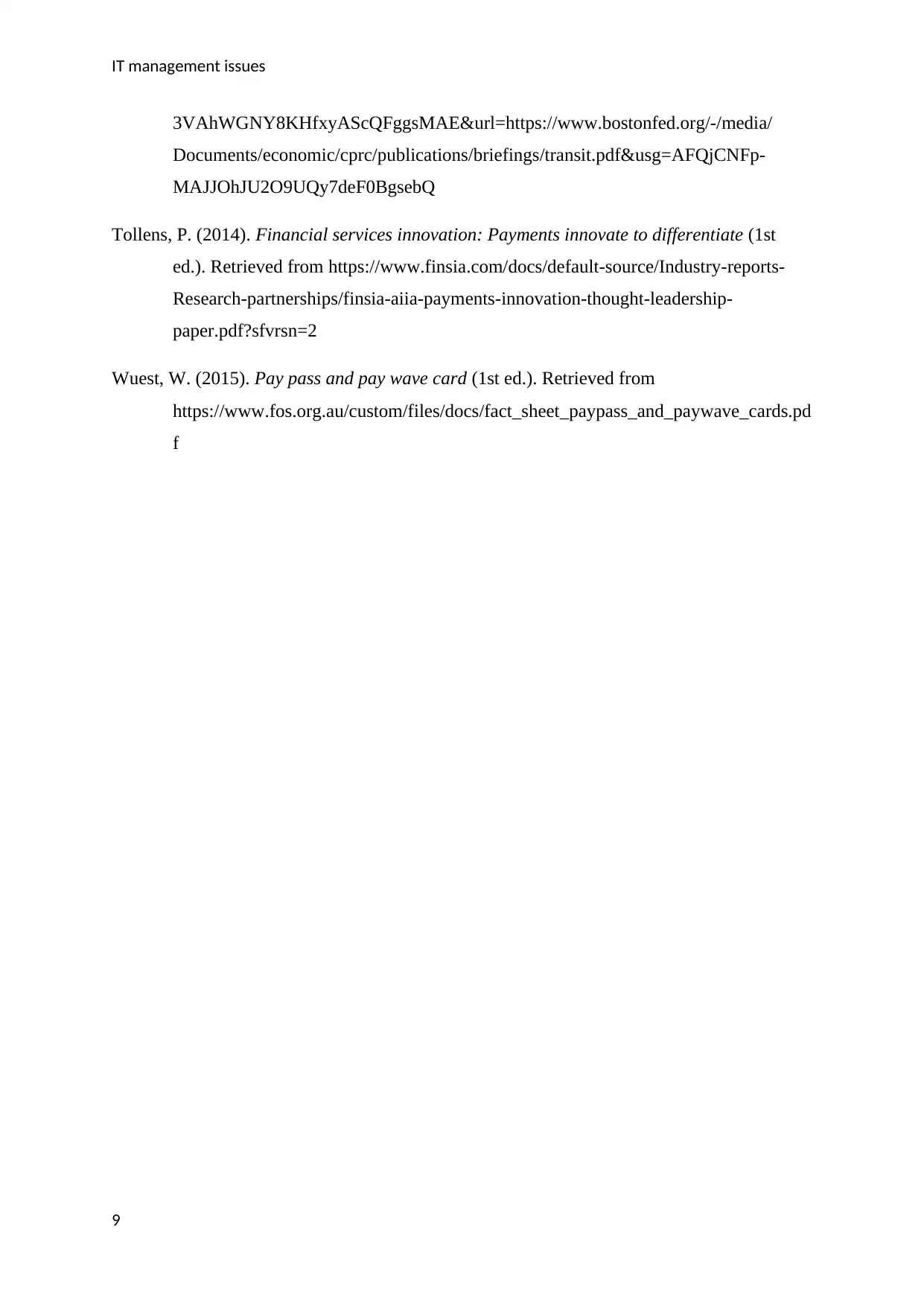
IT management issues
3VAhWGNY8KHfxyAScQFggsMAE&url=https://www.bostonfed.org/-/media/
Documents/economic/cprc/publications/briefings/transit.pdf&usg=AFQjCNFp-
MAJJOhJU2O9UQy7deF0BgsebQ
Tollens, P. (2014). Financial services innovation: Payments innovate to differentiate (1st
ed.). Retrieved from https://www.finsia.com/docs/default-source/Industry-reports-
Research-partnerships/finsia-aiia-payments-innovation-thought-leadership-
paper.pdf?sfvrsn=2
Wuest, W. (2015). Pay pass and pay wave card (1st ed.). Retrieved from
https://www.fos.org.au/custom/files/docs/fact_sheet_paypass_and_paywave_cards.pd
f
9
3VAhWGNY8KHfxyAScQFggsMAE&url=https://www.bostonfed.org/-/media/
Documents/economic/cprc/publications/briefings/transit.pdf&usg=AFQjCNFp-
MAJJOhJU2O9UQy7deF0BgsebQ
Tollens, P. (2014). Financial services innovation: Payments innovate to differentiate (1st
ed.). Retrieved from https://www.finsia.com/docs/default-source/Industry-reports-
Research-partnerships/finsia-aiia-payments-innovation-thought-leadership-
paper.pdf?sfvrsn=2
Wuest, W. (2015). Pay pass and pay wave card (1st ed.). Retrieved from
https://www.fos.org.au/custom/files/docs/fact_sheet_paypass_and_paywave_cards.pd
f
9
1 out of 10
Related Documents
Your All-in-One AI-Powered Toolkit for Academic Success.
+13062052269
info@desklib.com
Available 24*7 on WhatsApp / Email
![[object Object]](/_next/static/media/star-bottom.7253800d.svg)
Unlock your academic potential
© 2024 | Zucol Services PVT LTD | All rights reserved.





